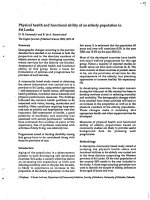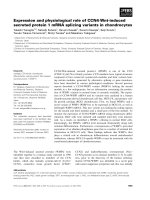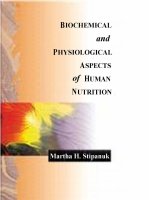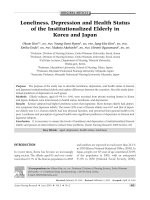Designing new screening methods and physiological dissection of anaerobic stress tolerance in rice
Bạn đang xem bản rút gọn của tài liệu. Xem và tải ngay bản đầy đủ của tài liệu tại đây (433.41 KB, 11 trang )
Int.J.Curr.Microbiol.App.Sci (2017) 6(5): 580-590
International Journal of Current Microbiology and Applied Sciences
ISSN: 2319-7706 Volume 6 Number 5 (2017) pp. 580-590
Journal homepage:
Original Research Article
/>
Designing New Screening Methods and Physiological Dissection of
Anaerobic Stress Tolerance in Rice
C. Partheeban1*, S. Srividhya1, M. Raveendran2 and D. Vijayalakshmi2
1
2
Department of Crop Physiology, TNAU, Coimbatore- 641 003, India
Department of Plant Biotechnology, Centre for Plant Molecular Biology and
Biotechnology, TNAU, Coimbatore - 641 003, India
*Corresponding author
ABSTRACT
Keywords
Rice, anaerobic
condition,
germination
percentage, alcohol
dehydrogenase,
amylase activity.
Article Info
Accepted:
04 April 2017
Available Online:
10 May 2017
Due to increasing practices of direct seeding in rice under rainfed and irrigated conditions,
tolerance to hypoxic or anaerobic condition is becoming an important trait. Considerable
genetic diversity is present in our native rice landraces and varieties which is unexploited.
Identifying and characterization of contrasting genotypes with acquired tolerance would
reveal new donors with improved water logging tolerance for breeding programs which
might be suitable for direct seeding systems. Apparently, there is lack of standard
screening procedure for anaerobic germination trait in the rice landraces and varieties of
Tamil Nadu. The present study designed new methods (Protray and beaker method) to
screen for anaerobic germination by assessing simple seed and seedling characters such as
germination per cent, greater shoot length by means of coleoptiles elongation and higher
vigor index to find the donors for anaerobic stress tolerance. Genotypes differing in their
tolerance to anaerobic germination were grouped as: (Highly Tolerant: Anaikomban,
Ottadaiyan, Muthuvellai, Rajamannar, CR1009; Moderately tolerant: Improved White
Ponni: Highly Susceptible: CO 43 and FR13A). Genotypes showing contrasting behavior
to anaerobic stress tolerance were selected to study the physiological basis of anaerobic
stress tolerance. The results showed that the tolerant genotypes recorded higher
germination per cent, greater shoot length by means of coleoptile elongation and recorded
higher vigor index. Further, the tolerant genotypes in this study depicted higher amylase
activity, higher Alcohol Dehydrogenase(ADH) activity and lower peroxidase activity
highlighting the role of these key enzymes to promote germination and survival under low
oxygen conditions.
Introduction
Rice is the most important cereal crop
worldwide and is the staple food of Indians.
Rice is grown under wide range of
ecosystems from marginal dry land to
waterlogged
wetlands,
with
lot
of
modifications in cultural practices to suit the
local environmental cues. Rice production
systems differ widely in cropping intensity
and yield, ranging from single-crop rainfed
lowland and upland rice with small yields (1–
3 t ha-1), to triple-crop irrigated systems with
an annual grain production of up to 15–18 t
ha-1. Irrigated and rainfed lowland rice
systems account for about 80% of the
worldwide harvested rice area and 92% of
total rice production. To keep pace with
580
Int.J.Curr.Microbiol.App.Sci (2017) 6(5): 580-590
activities of α-amylase, peroxidase and
alcohol dehydrogenase. Among these
enzymes, it has been reported that α-amylase
has a positive role in improving the
germination ability of the seed by degrading
starch into sugars (Perata et al., 1993). These
enzymes have been found to accumulate in
anaerobic tolerant rice lines whilst absent in
intolerant lines. In the absence of α-amylase,
starch is not hydrolyzed into sugar and the
anaerobic-intolerant lines experience sugar
starvation and ultimately fail to (Perata et al.,
1996). The enzyme alcohol dehydrogenase
via anaerobic fermentation metabolism has
been reported by several researchers to supply
ATP for seedling germination and survival
under anaerobic stress condition (Gibbs and
Greenway, 1996; Gibbs et al., 2000; Jackson
et al., 1982). Fermentation metabolism might
serve to be one of the important mechanisms
for the rice seedlings to establish and survive
under low oxygen conditions. Another
prominent enzyme that is found to be
regulated under anaerobic condition is the cell
wall peroxidases. This enzyme acts
antagonistically to cell wall extensibility
thereby inhibiting the cell elongation in
mungbean and peanut (Glodberg et al., 1987;
Zheng and Huystee, 1992; Ismail et al.,
2009). Thus, the characterization of these
biochemical changes under anaerobic
germination in rice would reveal the
adaptative mechanisms to understand
physiological bases of anaerobic stress
tolerance.
population growth, rice yields in both the
irrigated and rainfed lowland environments
must increase by 25% over the next 20 years.
Currently, upland and flood-prone rice
account for less than 8% of the global rice
supply, and it is unlikely that production from
these systems can be significantly increased
in the near future (FAO, 2014). Due to
increasing practices of direct seeding in
rainfed and irrigated conditions, tolerance to
hypoxic or anaerobic condition is becoming
an important trait. If heavy rain happens to
coincide during direct seeding, the entire crop
may be lost. It significantly reduces the yield
because of improper crop establishment.
Seed germination and seedling growth under
low oxygen stress conditions facilitates an
adaptive
mechanism
to
withstand
anaerobiosis (Magneschi and Perata, 2009).
Climate change projections suggest that
temperatures, precipitation, flooding and sea
level rise are likely to increase creating
adverse impacts on crop yield and farm
income (INCCA, 2010). Rice is therefore a
very interesting as a plant model to study how
plants can escape soil anaerobiosis, through
coleoptile elongation (Mapelli et al., 1995).
Apart from delayed germination and poor
seedling establishment, prolonged exposure to
hypoxic condition can lead to improper
nutrient availability and up takeas a result of
altered soil pH. In order to escape these
adverse conditions, rice plants have evolved a
mechanism called coleoptile elongation to
germinate and establish under low oxygen
conditions (Huang et al., 2003). Rice can
germinate under hypoxic or anoxic
conditions, but only tolerant genotypes have
the ability of fast coleoptile elongation and
root formation under submerged conditions in
the field (Ismail et al., 2009).
In Tamil Nadu, we have a wealth of
unexplored
germplasm
of
rice
varieties/landraces that evolved several
special traits to perform well under any
abiotic stress conditions. Apparently, there is
lack of standard protocols and methodologies
to screen genotypes for anaerobic germination
trait in the rice landraces and varieties of
Tamil Nadu. Hence, the study was aimed to
(i) Design rapid, reliable and repeatable
Anaerobic stress tolerance in rice is
accompanied by a series of biochemical
alterations such as, the changes in the enzyme
581
Int.J.Curr.Microbiol.App.Sci (2017) 6(5): 580-590
protocols to screen rice lines for improved
tolerance to anaerobic conditions (ii) to
identify suitable donors for anaerobic stress
tolerance among the popular rice varieties and
landraces of Tamil Nadu and (iii) to assess the
key physiological/biochemical traits and to
correlate important enzyme activities to
seedling survival under anaerobic conditions.
maintained. Germination percentage was
recorded 7th DAS and shoot length, root
length, vigor index and shoot-root ratio of 10
day old seedlings under anaerobic condition
were measured since roots of the sensitive
lines did not appear until about 7–8 d
following sowing.
Methods
adopted
to
assess
the
morphological traits associated with
seedling growth under low oxygen stress
Materials and Methods
Plant material
Contrasting genotypes for anaerobic stress
tolerance were germinated in the beaker
method with three replications each
containing 15 seeds per genotype. Seeds were
grown until 10 days and the germination
percentage, shoot length, root length, rootshoot ratio, vigor index were observed.
Germination percentage is measured by
calculating the number of seeds germinated to
the total number of seeds sown. The root
length, shoot length and root-shoot ratio were
calculated by pulling out the seedlings
without damaging their roots and washing
their roots gently. The vigor index was
calculated by using the formula viz.,(Shoot
length + Root length) * germination per cent).
Shoot length and root length were measured
in centimeters.
The seed materials consist of five popular
varieties and fourteen land races grown in
Tamil Nadu (Table 1). The seeds were
obtained from Paddy Breeding Station, Tamil
Nadu Agricultural University, Coimbatore.
Designing screening techniques to identify
rice lines for anaerobic stress tolerance
based on germination percentage
Initially,
anaerobic
germination
standardized by adopting two ways
was
Protray method: Portrays filled with black
soil and 15 seeds (3 seeds each for 5 holes)
for each of the 19 rice genotypes were sown
in portrays and placed inside a concrete
submergence tank with 10 cm water level, to
check for the germination percentage. Three
rows of replications were maintained for each
genotype. The germination percentage was
recorded at 7 days after sowing. A similar set
of genotypes, replicated the same way was
kept as control. These portrays were kept
inside another submergence tanks without
water. The plants were daily watered to
maintain optimum moisture content
Alteration in enzyme activities under
anaerobic stress
Enzymes such as α-amylase, peroxidase and
alcohol dehydrogenase activity were assessed
for the 10 day old seedlings subjected to
anaerobic stresses. Total amylase activity was
measured in the whole germinated seedlings
by following the method of Bernfeld et al
(1995). The absorption values were read at
540 nm on a standard curve established with
increasing amounts of maltose. Total protein
concentration was determined following the
Bradford method (Bradford, 1976) and the
activity expressed in units per milligram
Beaker method: 15 seeds from each of the
genotype were sown in a 500 mL beaker
filled with 4cm of soil and water level of 6 cm
(Fig 1.). Three replications of 15 seeds per
replication for each genotype were
582
Int.J.Curr.Microbiol.App.Sci (2017) 6(5): 580-590
protein. One unit of amylase activity is
defined as moles maltose produced per minute
and specific activity is expressed in terms of
units per mg protein.
portray method also showed tolerance and
susceptibility in beaker method. Hence, both
the methods can be used as rapid, reliable and
repeatable screening methods.
Crude protein was extracted from 100 mg of
tissue by grinding in 600 mL of ice-cold
extraction buffer (100 mM TES, pH7.7; 2
mM MgCl2.6H2O; 1 mM EDTA; 1.25 %
(w/v) TritonX-100; 4 mMdithiothreitol). The
crude extract was centrifuged at 10 000 g for
10 min at 5°C. Total ADH activity was
analyzed using the procedures described in
Ella et al., (1993) at 340 nm. Bradford’s
method (Bradford, 1976) was used for total
protein assay with bovine serum albumin as a
standard.
Identification of anaerobic stress tolerant
genotypes
Among the nineteen rice genotypes that were
germinated under anaerobic condition, the
landraces have been found to show higher
germination percentage when compared to the
popular varieties. Vergara et al., (2014) also
reported that landraces performed better
compared to the cultivated varieties under
stagnant flooding conditions. All the
genotypes taken for the study recorded 100
per cent germination percentage under control
condition created for both the methods
(Portray and Beaker).
Peroxidase activity was measured following
the procedure of Peru, (1962).One gram of
leaf was extracted in 0.1M phosphate buffer
(pH 7.0). A known volume of the extract was
added to a cuvette containing 3ml phosphate
buffer and 3ml pyrogallol was added and the
increase in absorbance at 430 nm was
recorded. The change in absorbance in
minutes was used to calculate the enzyme
activity.
Fig 2, showed that the genotypes that
recorded a germination percentage of more
than 90 % under anaerobic condition were
regarded as highly tolerant to low oxygen
stress, as seed germination is a critical point
in seedling establishment and subsequent
plant vigor (Manigbas et al., 2008; Miro and
Ismail, 2013). The genotypes CO 43 and
FR13A recorded the lowest germination per
cent (10%), and hence were regarded as
highly susceptible genotypes. Improved
White Ponni was classified as moderately
tolerant genotype with germination per cent
of 70%. The land races Ottadaiyan and
Rajamannar recorded a high germination per
cent of 96%; Muthuvellai and CR1009
recorded 94 and 95 per cent germination
respectively. The genotype Anaikomban
recorded 100 per cent germination. The study
clearly stated that there is a wide genetic
variation for anaerobic germination in rice.
This is in line with the findings of Ismail et
al., (2009) and Vergara et al., (2014). Based
on germination percentage under low oxygen
stress the genotypes were grouped as Highly
Results and Discussion
Validation of methods adopted to screen
rice genotypes for anaerobic stress
tolerance
Two screening methods (Portray and Beaker)
were designed and all the 19 genotypes were
subjected to low oxygen stress by flooding
them. Development of different screening
methods for anaerobic germination has also
been reported by Mapelli et al., (1995) for
rice and wheat; Ismail et al., (2009) for rice.
Germination per cent was recorded on 7th day.
In both portray and beaker methods, same
results were reported. Rice lines that were
screened as tolerant and susceptible by
583
Int.J.Curr.Microbiol.App.Sci (2017) 6(5): 580-590
tolerant
(Anaikomban,
Ottadaiyan,
Muthuvellai,
Rajamannar,
CR1009),
Moderately tolerant (Improved White Ponni)
and Highly Susceptible (CO 43 and
FR13A)(Fig 3). Thus, the highly tolerant
genotypes can be exploited as donors in crop
improvement programmes aiming for
tolerance to anaerobic stress conditions.
Vergara et al., (2014) also reported that
variation in tolerance of rice to long-term
stagnant flooding that submerges most of the
shoot will aid in breeding tolerant cultivars.
Regarding the shoot and root length, it was
observed that the genotype Anaikomban
recorded the longest shoot length (27.6 cm),
while FR 13A recorded the shortest shoot
length (2.0 cm) compared to other genotypes.
The tolerant landrace Rajamannar was
observed to record a greater shoot length
(20.9 cm) and the longest root length (8.3 cm)
compared to other genotypes. The results
obtained from this study showed that higher
the germination per cent greater was the vigor
index
for
seedling
establishment.
Anaikomban recorded the highest vigor index
both under control (2940) and stress (3430)
condition while the vigor index was low in
the genotype FR13A (control-1530; stress13). Similar trends were observed for rootshoot ratio with the tolerant genotype
recording the lowest root-shoot ratio and viceversa in the intolerant. The study thus clearly
signify the negative correlation between
seedling growth, vigor index and root shoot
ratio. Hence, morpho-physiological traits
attributed for anaerobic stress tolerance are
germination per cent, greater shoot length by
means of coleoptile elongation and higher
vigor index. Since the rice seedlings escape
low oxygen stress by coleoptile elongation
rather than root emergence, the tolerant
genotypes also recorded higher shoot: root
ratio (Miro and Ismail, 2013).
Morpho-physiological traits in contrasting
rice genotypes subjected to anaerobic
stresses
The tolerance/susceptibility of rice lines to
anaerobic stresses screened in portray method
was confirmed in beaker method using simple
morpho-physiological
parameters
like
germination percentage, shoot length, root
length, vigor index and root-shoot ratio.
Manigbas et al., (2008) has also reported the
need for developing a standard screening
method for anaerobic seed germination using
different rice genotypes. All the parameters
were recorded on 7th after sowing in the
highly tolerant and highly susceptible
genotypes.
All the genotypes under control recorded 100
per cent germination. Under anaerobic stress
condition, Anaikomban recorded highest
germination percentage of 100 while Co 43,
FR 13A were found to be highly sensitive
under low oxygen stress with a germination
per cent of 12 and 5 respectively. The
genotypes Ottadaiyan and Muthuvellai
recorded germination per cent of 96, while
Rajamannar and CR 1009 recorded a
germination per cent of 94 and 92 per cent
respectively (Table 2). The genotype
Improved White Ponni recorded 72 per cent
germination. These results further confirmed
the results obtained in the previous
experimental set up.
Understanding the Physiological basis of
anaerobic stress tolerance by assessing the
alterations in the enzyme activities
The activities of α-amylase, Alcohol
Dehydrogenase and Peroxidase were assessed
in 10 days old seedlings both under control
and low oxygen stress conditions. Under
control conditions the enzyme activities did
not show any significant variation among the
genotypes. Hence, the enzyme activities of
the tolerant and intolerant genotypes under
anaerobic stress conditions are alone
discussed below (Table 3).
584
Int.J.Curr.Microbiol.App.Sci (2017) 6(5): 580-590
The genotype Anaikomban recorded the
highest (32.18 Units mg–1 protein)α-amylase
activity under anaerobic stress condition and
FR13A and CO43 recorded the lowest (10.45;
8.13 Units mg–1 protein) enzyme activity. αamylases are believed to play a vital role in
the breakdown of starch (Magneschi and
Perata, 2009)and rice seeds are capable of
degrading starch during germination under
anoxic condition to generate ATP required for
the germinating embryos (Perata et al.,
1992;Perata et al., 1993,Guglielminetti et al.,
1997). Thus, in line with the above findings,
the present study also that the tolerant
genotype Anaikomban recorded higher
amylase activity highlighting the role in
ability to survive and grow faster under low
oxygen conditions. On the contrary, the
sensitive genotypes recorded very low
amylase enzyme activity. Hence, a positive
correlation (r2=0.64) between germination
percentage and α-amylase activity was
observed in the study (Fig.4). Ismail et al.,
(2009) has also reported that the higher
amylase activity during submergence is
consistent with the faster growth observed in
tolerant genotypes compared with intolerant
ones, and is also illustrated by the strong
positive correlations with shoot and root
lengths during flooding.
The enzyme alcohol dehydrogenase (ADH)
via anaerobic fermentation metabolism has
been reported by several researchers to supply
ATP for seedling germination and survival
under anaerobic stress conditions (Gibbs and
Greenway, 1996; Gibbs et al., 2000; Jackson
et al., 1982). Alcohol dehydrogenase activity
was found to be highest in Muthuvellai
(1.93Units min–1mg–1 protein) followed by
CR1009 (1.71Units min–1mg–1 protein) and
Anaikomban (1.23Units min–1mg–1 protein).
The sensitive genotype FR13A was observed
to record lowest (0.26Units min–1mg–1
protein) ADH activity.
Table.1 List of rice genotypes used for the study
S. No.
1
2
3
4
5
6
7
8
9
10
11
12
13
14
15
16
17
18
19
Rice varieties/landraces
Popular varieties
CO 43
CO 50
CR1009
IMPROVED WHITE PONNI
IR64
Landraces
ANAIKOMBAN
APO
FL48
FR13A
KALIYANA SAMBA
KALLURNDAIKAR
KARTHIGAI SAMBA
KODAVARI SAMBA
KOMBALAI
MUTHUVELLAI
NORUNGAN
OTTADIAYAN
RAJAMANNAR
RASACADAM
585
Int.J.Curr.Microbiol.App.Sci (2017) 6(5): 580-590
Table.2 Effect of anaerobic germination on seedling characters in rice genotypes
Genotype
Anaikomban
Ottadaiyan
Muthuvellai
Rajamannar
CR1009
Improved
white Ponni
Co 43
FR13A
Germination
percentage
Shoot length (cm)
Root length (cm)
Stress
Control
27.6±0.092 10.3±0.034
19.4±0.067 8.1±0.028
18.5±0.064 9.2±0.032
20.9±0.085 10.7±0.043
20.2±0.134 8.6±0.057
Vigor Index
Root: shoot ratio
100±0.334
96±0.334
96±0.390
94±0.327
92±0.690
Control
19.1±0.064
17.2±0.060
17.4±0.061
16.7±0.068
12.9±0.085
72±0.593
14.8±0.122 10.3±0.126
7.1±0.058
4.4±0.036
2190
1418
0.4797
0.2876
12±0.040
5±0.017
10.1±0.034
10.3±0.036
6.8±0.023
5.0±0.017
2.9±0.010
0.6±0.002
1690
1530
79
13
0.6733
0.4854
0.7838
0.3000
3.7±0.012
2.0±0.007
Stress
Control Stress Control Stress
6.7±0.022
2940
3430
0.5393 0.2428
5.8±0.020
2530
2419
0.4709 0.2990
6.4±0.022
2660
2341
0.5287 0.3459
8.3±0.034
2740
2803
0.6407 0.3971
5.2±0.034
2150
2337
0.6667 0.2574
Table.3 Effect of anaerobic germination on the enzyme activities (α-amylase, peroxidase and
alcohol dehydrogenase) in rice seedlings
Anaikomban
Ottadaiyan
Muthuvellai
Rajamannar
CR1009
Improved white Ponni
Co 43
FR13A
α -Amylase activity
(Units mg–1
protein)
32.18± 0.108
20.09±0.070
28.76±0.117
22.18±0.077
23.40±0.155
12.05±0.040
10.45±0.086
8.13±0.028
Alcohol dehydrogenase
activity (ADH)
(Units min–1mg–1 protein)
1.23±0.004
0.87±0.003
1.93±0.008
0.82±0.003
1.71±0.011
0.63±0.005
0.44±0.001
0.26±0.001
Peroxidase (POX)
(Units min–1mg –1protein)
0.38±0.001
1.12±0.004
2.11±0.009
1.77±0.006
2.12±0.014
9.56±0.079
11.10±0.037
12.49±0.043
Fig.1 Anaerobic germination screening of rice genotypes by a) portray and b) beaker methods
586
Int.J.Curr.Microbiol.App.Sci (2017) 6(5): 580-590
Fig.2 Anaerobic germination percentage (%) of rice genotypes grown in portrays/ beakers
Fig.3 Z- Distribution graph between germination percentage (%) and shoot length (cm) in rice
genotypes under anaerobic condition. Quadrant I depicts the highly tolerant genotypes, Quadrant
II shows the moderately tolerant genotype and the Quadrant III shows the susceptible genotypes
587
Int.J.Curr.Microbiol.App.Sci (2017) 6(5): 580-590
Fig.4 Correlation between germination percentage (%) and α- amylase activity (Units mg–1
protein) of rice seedlings under anaerobic stress
Fig.5 Correlation between germination percentage (%) and ADH activity (Units min–1mg –
1protein) of rice seedlings under anaerobic stress
Fig.6 Correlation between shoot length (cm) and peroxidase activity (Units min–1mg –1protein)
of rice seedlings under anaerobic stress
588
Int.J.Curr.Microbiol.App.Sci (2017) 6(5): 580-590
identified as higher α-amylase and ADH
activity which are positively correlated to
higher germination per cent under low oxygen
stress. Higher POX activity in rice seedlings
were negatively correlated to germination per
cent under low oxygen stress. Thus, genetic
variability in acquired tolerance to anaerobic
germination in landraces of rice reveals new
sources of donors for anaerobic germination
under direct seeding.
A positive correlation between the
germination percentage and the ADH activity
(Fig.5) with the correlation coefficient of r2=
0.53 was reported in this study similar to the
findings of Miro and Ismail, (2013). This
explains that higher the ADH activity higher
will be the germination per cent and higher
will be the survival rate and seedling
establishment. Also, the ability of the
seedlings to maintain an active formative
metabolism is very crucial to survive under
the anoxic conditions (Magneschi and Perata,
2009).
Acknowledgement
The authors thank the Department of Crop
Physiology for providing the necessary
facilities for this work.
Generally it was observed that peroxidase
activity was low in the tolerant genotypes
(Anaikomban-0.38Units min–1mg–1 protein;
Ottadaiyan-1.12Units min–1mg–1 protein) and
highest in the sensitive genotypes (FR13A12.49 Units min–1mg–1 protein; CO4311.10Units min–1mg–1 protein). Peroxidases
are reported to inhibit the cell wall extension
which promotes the coleoptile elongation
(Ismail et al., 2009). In line with the above
findings, a strong negative correlation was
observed for the shoot length and peroxidase
enzyme activity (r2=0.84) in the present study.
Lee and Lin, (1996) have also reported a
negative correlation between shoot elongation
and peroxidase activity (Fig.6). Germination
percentage was found to be positively
correlated with the α-amylase and ADH
activity but negatively correlated with
peroxidase activity.
References
Bernfeld, P. 1955. Amylases, alpha and beta.
Meth. Enzymol., 1: 149–58
Bradford, M.M. 1976. A rapid and sensitive
method for quantitation of microgram
quantities of protein utilizing the principle
of protein-dye binding. Ann. Biochem., 72:
248–254.
Ella, E.S., A.P. Valdez, R.V. Reyes, H. Greenway
and Setter, T.L. 1993. Importance of
several enzymes in limitation of alcoholic
fermentation of rice under anoxia.
Proceedings of the 6th Annual Meeting of
the International Program on Rice
Biotechnology, Chiang Mai, Thailand.
Gibbs, J., and Greenway, H. 2003. Mechanisms of
anoxia tolerance in plants. I. Growth,
survival
and
anaerobic
catabolism.
Functional Plant Biol., 30: 1–47
Gibbs, J., S. Morrell, A. Valdez, T.L. Setter and
Greenway, T. 2000. Regulation of alcoholic
fermentation in coleoptiles of two rice
cultivars differing in tolerance to anoxia. J.
Exp. Bot., 51: 785–796
Goldberg, R., M. Liberman, C. Mathieu, M.
Peirron and Catesson, A.M. 1987.
Development of epidermal cell wall
peroxidase along the mung bean
hypocotyls: possible involvement in the cell
wall stiffening process. J. Exp. Bot., 38:
1378–1390.
In conclusion, a more reliable, rapid and
repeatable method using the protrays/beakers
to screen the genotypes for anaerobic stress
tolerance was designed in this study. The
study has also led to the identification of three
landraces namely Anaikomban, Muthuvellai
and Rajamannar and a variety CR1009 as
donors for anaerobic stress tolerance that
embed this trait to germinate under anaerobic
condition. The important physiological
mechanisms underlying stress tolerance was
589
Int.J.Curr.Microbiol.App.Sci (2017) 6(5): 580-590
Guglielminetti, L., Y. Wu, E. Boschi, J.
Yamaguchi, A. Favati, M. Vergara, P.
Perata, and Alpi, A. 1997. Effects of anoxia
on sucrose degrading enzymes in cereal
seeds. J. Plant Physiol., 150: 251–258
Huang, S.B., H. Greenway and Colmer, T.D.
2003. Anoxia tolerance in rice seedlings:
exogenous glucose improves growth of an
anoxia-’intolerant’, but not of a ‘tolerant’
genotype. J. Exp. Bot., 54: 2363–2373
INCCA (Indian Networkfor Climate Change
Assessment). 2010. Climate change and
India - A 4X4 Assessment, A Sectoral and
Regional Analysis for 2030s: Ministry of
Environment and Forests, Government of
India
Ismail, A.M., E.S. Ella, G.V. Vergara and
Mackill, D.J. 2009. Mechanisms associated
with tolerance to flooding during
germination and early seedling growth in
rice (Oryza sativa). Ann. Bot., 103: 197-209
Jackson, M.B., B. Herman and Goodenough, A.
1982. An examination of the importance of
ethanol in causing injury to flooded plants.
Plant Cell Environ., 5: 163–172.
Lee, T.M., and Lin, Y.H. 1996. Peroxidase
activity in relation to ethylene-induced rice
(Oryza sativa L.) coleoptile elongation.
Botanical Bull. Academia Sinica, 37: 239–
245.
Magneschi, L., and Perata, P. 2009. Rice
germination and seedling growth in the
absence of oxygen. Ann. Bot., 103: 181-196
Manigbas, N.L., O.S. Renando, V.B. Wilhelmina,
J.N. Angelo, C.A. Emily, F.P. Thelma and
Rolando, T.C. 2008. Development of
screening
methods
for
anaerobic
germination and seedling vigor in direct
seeded wet seeded rice culture. Philippine
J. Crop Sci., 33(3): 34-44.
Mapelli, S., F. Locatelli and Bertani, A. 1995.
Effect of anaerobic environment on
germination and growth of rice and wheat:
endogenous levels of ABA and IAA.
Bulgarian J. Plant Physiol., 21: 33–41.
Miro, B., and Ismail, M. 2013. Tolerance of
anaerobic conditions caused by flooding
during germination and early growth in rice
(Oryza sativa L.). Frontiers Plant Sci., 4: 118.
Perata, P., N. Geshi, J. Yamaguchi and Akazawa,
T. 1993. Effect of anoxia on the induction
of alpha-amylase in cereal seeds. Planta,
191: 402–408
Perata, P., L. Guglielminetti and Alpi, A. 1996.
Anaerobic carbohydrate metabolism in
wheat and barley, two anoxia-intolerant
cereal seeds. J. Exp. Bot., 47: 999–1006.
Perata, P., J. Pozuetaromero, T. Akazawa and
Yamaguchi, J. 1992. Effect of anoxia on
starch breakdown in rice and wheat seeds.
Planta, 188: 611–618.
Peru, N.G. 1962. Measurement of peroxidase
activity in plant tissues. Curr. Sci., 31: 7181
Vergara, G.V., Y. Nugraha, M.Q. Esguerra, D.J.
Mackill and Ismail, A.M. 2014. Variation
in tolerance of rice to long-term stagnant
flooding that submerges most of the shoot
will aid in breeding tolerant cultivars. AoB
Plants, 6: 1-16.
Zheng, X., and van Huystee, R.B. 1992.
Peroxidase-regulated
elongation
of
segments from peanut hypocotyls. Plant
Sci., 81: 47–56.
How to cite this article:
Partheeban, C., S. Srividhya, M. Raveendran and Vijayalakshmi, D. 2017. Designing New
Screening Methods and Physiological Dissection of Anaerobic Stress Tolerance in Rice.
Int.J.Curr.Microbiol.App.Sci. 6(5): 580-590. doi: />
590









